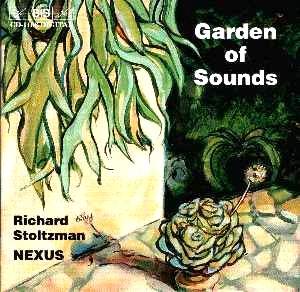"GARDEN OF SOUNDS"
Music for Clarinet and Percussion
 Richard Stoltzman (clarinet)
Nexus. Percussion Ensemble. Bob Becker; Bill Cahn; Robin Engleman; Russell
Hartenberger.
Richard Stoltzman (clarinet)
Nexus. Percussion Ensemble. Bob Becker; Bill Cahn; Robin Engleman; Russell
Hartenberger.
 Recorded CBC Studio 44, Toronto.
22 Jan 1999 BIS. CD - 1108 DDD
[71'44"]
Recorded CBC Studio 44, Toronto.
22 Jan 1999 BIS. CD - 1108 DDD
[71'44"]
Crotchet
Amazon
UK
Amazon
USA

In the contemporary world, so much depends upon being able to put people
and their doings into the correct categories. Governments and officialdom
do it all the time, but even at the everyday level there is a tendency to
be slightly cautious about anything which cannot readily be pigeon-holed.
These philosophical meanderings are a reviewer's waffle while he tries to
think of something to say about a CD such as the one detailed above. The
title "Garden of Sounds", incidentally is a phrase Toru Takemitsu used. As
a friend and mentor the work is dedicated to his memory.
On this BIS disc there are thirteen sections, each one separately named -
"Eternal Triangle Beckons", "Wonderings", "Rhapsody in
Green" - and so on. None has any thematic connection with any other section.
Each part has the same constant elements, the solo clarinet of Richard Stoltzman
and the four members of the percussion ensemble Nexus playing from
their array of instruments - as co-soloists, not in any way as a rhythm support.
The problem is, I cannot, decide what sort of music it is. What it isn't
is what you and I would agree to be "classical", nor is it pop, nor crossover,
nor would it come under the umbrella of "World Music". In no way is it Jazz
either, despite the reference to improvisation in the supplied notes. Let
me quote from those notes. "The music in this "Garden of Sounds" is spontaneous.
It is free-form improvisation, inspired by a mutual interest among the artists
in exploring this kind of musical creation. By listening intensely, by allowing
(rather than forcing) one's innermost being to be evoked, and by harnessing
skills developed over many years of experience, the music is born". There
follows an approving reference to a quotation from Cornelius Cardew, the
composer, which reads, in part "Improvisation cannot be rehearsed".
This is where the writer and I part company. To me 'spontaneous' means 'of
the moment, now, without rehearsal'. I find it hard to believe that players
of the skills and professionalism shown in this recording simply start the
tapes and go on from there absolutely from scratch. Remember there can be
five individuals involved in difficult and numerous switches from instrument
to instrument, that would involve considerable actual movement for the
percussionists. Some choreography must have been pre-arranged, surely? Or
am I being too pedantic? What about stage performances of their material?
Jazz solos are often spontaneous (the first time they're played) but even
the best jazz is usually arranged even if it is only to fix the order of
soloist. Imagine the Duke one night saying "Right lads, for tonight take
your solos when it suits you. You, Johnny (Hodges) and Ben (Webster) - come
in when you're ready".
I can offer nothing but praise for the playing. Richard Stoltzman is a top-flight
performer with a warm tone and impressive control. He obviously would be
at home in any company at any level. The percussionists too are highly
impressive. The list of their collection of instruments is remarkable and
is as follows: Marimba, vibraphone, Deagan "Songbells", Emax keyboard, steel
pans, amadinda (Ugandan xylophone), bass drums, conga and bongo drums, Ghanian
drums, concert tom toms, ocarinas, Waterphones, quicas (Brazilian friction
drums), bass harmonic, panpipes, chang (Chinese zither), toy accordion, various
types of cymbals, and dozens of rattles, shakers, scrapers and wooden and
metallic percussion instruments from all over the world. Included there you
will see several melodic instruments which added some variety to the programme.
So what do you hear? A highly original and intriguing aural world of
conventionally tonal playing on clarinet and snatches of a piano accordion,
keyboard or harmonica. The clarinet playing varies from jazzy to rhapsodic,
occasionally being no more than a supporting role in the sound picture with
the odd interpolated phrase or single note.
There is nothing you would recognise - except in No 9 when there are snatches
of "Yankee Doodle" and "Amazing Grace" in an almost Ivesian piece ("Amazin'
Gazin' - they call it). With it is this incredible range and variety of sounds
- very slow, very fast, very quiet and VERY loud - from the percussion. All
helped by a magnificently clear and balanced recording.
An interesting recording even if I still don't know what to classify it as.
Only devotees of percussionism are likely to listen to it regularly but more
casual listeners might think it worth a try. I would suggest an auditioning
at your dealer's might be worthwhile before buying.
Reviewer
Harry Downey

